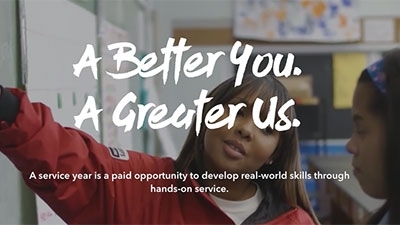The service year as alternative to military service for all American youth is more than a big idea. It’s happening right now, thanks to the Service Year Alliance (SYA) and its partnership with hundreds of service year programs throughout the nation. Right now, 65,000 young Americans are working in a service year job with a nonprofit organization. The goal is much bigger: service year programs that involve 1 million students each year. One way to bring this work to scale is by taking a statewide approach, and the Commonwealth of Virginia is showing us how.
Pioneering colleges and universities in Virginia are working with governmental agencies and organizations in the state to provide service year opportunities for students. The work began with the College of William & Mary and James Madison University sponsoring summits on the service year concept. Those meetings led to the signing of the Compact on National Service in Richmond in early 2016. Dorothy McAuliffe, wife of Virginia Gov. Terry McAuliffe, took the next step. She invited SYA to meet with the Virginia Department of Social Services in collaboration with the Governor’s Advisory Board on Service and Volunteerism, Virginia Engage network, and higher education leaders across the commonwealth at the first Governor’s Summit on Advancing Engagement in the Commonwealth. At the summit, held in October at Averett University in Danville, college and university leaders from across the state learned how service year programs work and considered next steps.
This big idea gathered steam as many of Virginia’s colleges and universities have implemented strategies to make a service year a part of what it means to participate in higher education. These built on the state’s notable history of helping students succeed. For example, in 2005, the University of Virginia launched the Virginia College Advising Corps which became the model for the national College Advising Corps, now at work in 15 states, with 597 advisers in service.
Since then, other examples have followed, including:
- James Madison University and the College of William & Mary host service year fellowship programs for post-graduate students that focus on community engagement.
- Through the Service Year + Higher Education Innovation Challenge, Blue Ridge Community College is piloting a Trailblazers program in which second-year students at Blue Ridge mentor at-risk students from area high schools, model successful life skills, and help prepare the high-schoolers for college.
- George Mason University, the University of Virginia, Virginia State University, and Virginia Wesleyan College prepare students to enter the Peace Corps through Peace Corps prep programs.
Additional institutions are embracing the service year in other ways. For example:
- Averett University is the first higher education institution to become an Employer of National Service. Averett is launching two post-graduate fellowships in summer 2017 and exploring a program to connect service to academic credit.
- Shenandoah University is among many whose career services offices offer programming for students to learn about post-graduate service opportunities and link to SYA’s Service Year Exchange.
Many Virginia communities ─ in many public sector areas ─ have identified service year placements. Examples of four types of placements include:
- Cultivating youth development with Alternatives, Inc. and Aspire Afterschool Learning.
- Assisting the Virginia Veterans Corps with civilian-to-military transition.
- Preserving natural and historical resources through Virginia state parks, Student Conservation Association, and Virginia Veterans Corps.
- Addressing homelessness and food insecurity through CARITAS, Beans and Rice, Inc.
National programs such as Teach for America also have a presence in the commonwealth, and Virginia Tech and Virginia Commonwealth universities host AmeriCorps programs which create jobs and provide career pathways for thousands of young adults.
The innovative Virginia approach to service year expansion could be replicated in any state, particularly those with strong state-level collaboration among higher education institutions and state agencies. Leadership from three sectors ─ state policy, higher education, and the community ─ is especially critical to realize the vision of creating 1 million job placements in the public sector annually. If they step up to lead this vision in all the states, think of how many employers, communities, and youth will benefit. A win-win for all ─ and a true service to our nation.
